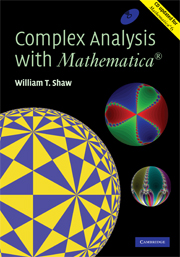Book contents
- Frontmatter
- Contents
- Preface
- 1 Why you need complex numbers
- 2 Complex algebra and geometry
- 3 Cubics, quartics and visualization of complex roots
- 4 Newton—Raphson iteration and complex fractals
- 5 A complex view of the real logistic map
- 6 The Mandelbrot set
- 7 Symmetric chaos in the complex plane
- 8 Complex functions
- 9 Sequences, series and power series
- 10 Complex differentiation
- 11 Paths and complex integration
- 12 Cauchy's theorem
- 13 Cauchy's integral formula and its remarkable consequences
- 14 Laurent series, zeroes, singularities and residues
- 15 Residue calculus: integration, summation and the argument principle
- 16 Conformal mapping I: simple mappings and Möbius transforms
- 17 Fourier transforms
- 18 Laplace transforms
- 19 Elementary applications to two-dimensional physics
- 20 Numerical transform techniques
- 21 Conformal mapping II: the Schwarz—Christoffel mapping
- 22 Tiling the Euclidean and hyperbolic planes
- 23 Physics in three and four dimensions I
- 24 Physics in three and four dimensions II
- Bibliograpy
- Index
7 - Symmetric chaos in the complex plane
Published online by Cambridge University Press: 05 August 2014
- Frontmatter
- Contents
- Preface
- 1 Why you need complex numbers
- 2 Complex algebra and geometry
- 3 Cubics, quartics and visualization of complex roots
- 4 Newton—Raphson iteration and complex fractals
- 5 A complex view of the real logistic map
- 6 The Mandelbrot set
- 7 Symmetric chaos in the complex plane
- 8 Complex functions
- 9 Sequences, series and power series
- 10 Complex differentiation
- 11 Paths and complex integration
- 12 Cauchy's theorem
- 13 Cauchy's integral formula and its remarkable consequences
- 14 Laurent series, zeroes, singularities and residues
- 15 Residue calculus: integration, summation and the argument principle
- 16 Conformal mapping I: simple mappings and Möbius transforms
- 17 Fourier transforms
- 18 Laplace transforms
- 19 Elementary applications to two-dimensional physics
- 20 Numerical transform techniques
- 21 Conformal mapping II: the Schwarz—Christoffel mapping
- 22 Tiling the Euclidean and hyperbolic planes
- 23 Physics in three and four dimensions I
- 24 Physics in three and four dimensions II
- Bibliograpy
- Index
Summary
Introduction
The existence of functions such as Nest and NestList, together with extensive visualization tools, ensure that Mathematica is a natural system for investigating the iteration of mappings. One favourite is the logistic map that was considered in Chapter 5. Complex numbers play a very natural role, from two quite different points of view. First, we wish to understand why maps such as the logistic map behave the way they do, without relying merely on numerical simulation. Second, we wish to extend the use of numerical simulation to mappings of the complex plane.
You explored the first point in Chapter 5, and the second in Chapters 4 and 6, for simple polynomial maps. Now you will consider some other mappings of the complex plane into itself. These mappings are non-holomorphic (in the sense that will be defined properly in Chapter 10 – for now it suffices to realize that this means the functions involve complex conjugation in an essential way). Normally, when considering the theory of complex numbers, one's interest is quite rightly focused on the analytical properties of holomorphic or meromorphic functions. I hope the constructions described here will suggest that there is much that is both beautiful and interesting in complex structures that are not holomorphic. My approach is based on that of Field and Golubitsky (1992), and the use of Mathematica on this topic was first given by the author (Shaw, 1995).
- Type
- Chapter
- Information
- Complex Analysis with MATHEMATICA® , pp. 138 - 158Publisher: Cambridge University PressPrint publication year: 2006



